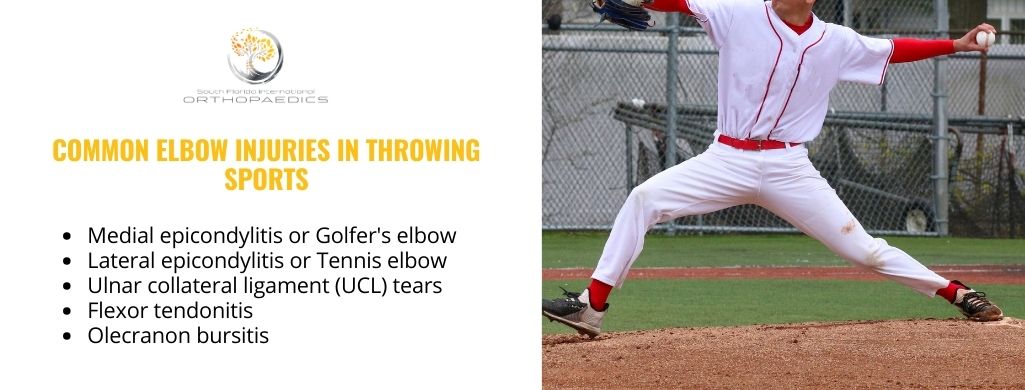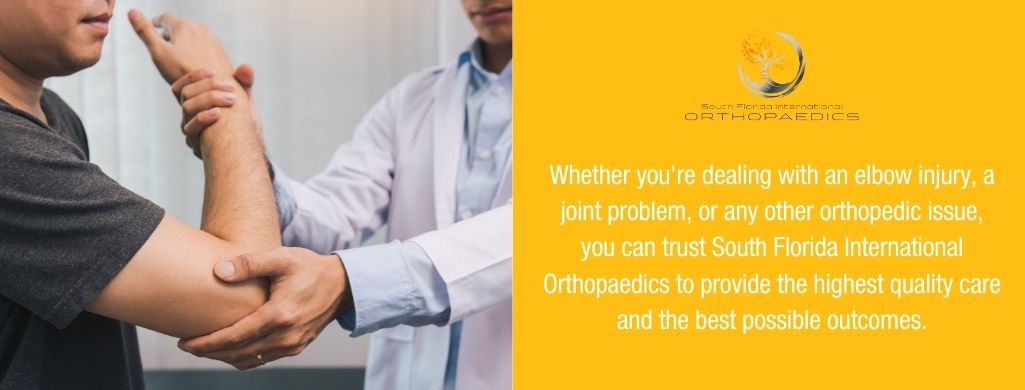As an athlete competing in throwing sports, your elbows are your most valuable asset. Yet, they’re also susceptible to a range of injuries that can jeopardize your performance and sideline you from the game.

In this comprehensive guide, we’ll explore everything you need to know about elbow injuries in throwing sports – from recognizing the warning signs of injury and implementing preventative measures to exploring treatment options and ensuring long-term elbow health.
What are the different types of elbow injuries associated with throwing?
Elbow injuries in throwing sports often stem from the repetitive and high-velocity nature of throwing motions.
These injuries can result from poor throwing mechanics, overuse, inadequate rest, or insufficient conditioning of the muscles and ligaments surrounding the elbow joint. The most common types of injuries include:
1. Medial epicondylitis (Golfer’s elbow)
This condition involves inflammation or irritation of the tendons on the inner side of the elbow, specifically the tendons that attach to the medial epicondyle (the bony prominence on the inner side of the elbow).
Symptoms may include pain and tenderness on the inner side of the elbow, weakness in gripping or lifting objects, and worsening pain with specific movements.
2. Lateral epicondylitis (Tennis elbow)
Lateral epicondylitis is characterized by inflammation or irritation of the tendons on the outer side of the elbow, specifically the tendons that attach to the lateral epicondyle (the bony prominence on the outer side of the elbow).
While it is commonly referred to as “tennis elbow,” it can also occur in due to repetitive stress on the wrist and forearm muscles.
Symptoms typically include pain and tenderness on the outer side of the elbow, especially with gripping, lifting, or twisting movements.
3. Ulnar collateral ligament (UCL) tears
The UCL is a thick band of tissue on the inner side of the elbow that provides stability to the joint during throwing motions.
UCL tears can occur gradually over time due to repetitive stress on the ligament or suddenly due to a traumatic event, such as a forceful throw.
Symptoms may include pain on the inner side of the elbow, a feeling of instability or “looseness” in the joint, decreased throwing velocity or accuracy and swelling.
4. Flexor tendonitis
Flexor tendonitis involves inflammation or irritation of the tendons that flex the wrist and fingers, which can occur due to repetitive throwing motions.
Symptoms may include pain and stiffness in the forearm and elbow, particularly during and after throwing activities, and weakness in gripping or squeezing objects.
5. Olecranon bursitis
Olecranon bursitis is characterized by inflammation or irritation of the bursa, a fluid-filled sac at the tip of the elbow.
Symptoms may include swelling, tenderness, and redness at the back of the elbow, as well as pain with movement or pressure on the area.
How to treat elbow pain from throwing?

When it comes to treating elbow injuries resulting from the throwing motion, a multi-faceted approach is often necessary. Depending on the severity and nature of the injury, treatment options may include:
- Rest, ice, compression, and elevation (RICE)
- Nonsteroidal anti-inflammatory drugs (NSAIDs)
- Physical therapy
- Corticosteroid injections
- Surgery (in severe cases)
Working closely with a sports medicine physician or physical therapist can help tailor a treatment plan to your needs and goals.
What are the best recovery strategies after an elbow injury?
Rest and recovery are crucial components of the healing process for elbow injuries. It’s essential to allow adequate time for the injured tissues to heal properly before returning to throwing activities.
During this time, you will be advised to focus on the following recovery strategies:
- Use gentle range of motion exercises to strengthen the surrounding muscles.
- Maintaining overall fitness to help facilitate recovery and prevent deconditioning.
- Ongoing maintenance exercises even after recovery.
- Regular monitoring of throwing mechanics.
- Proactive measures to address any early signs of overuse or fatigue
Additionally, maintaining overall physical fitness and incorporating cross-training activities can help reduce the risk of future injuries.
When can you safely return to your sport?
Returning to throwing after an elbow injury requires careful consideration and gradual progression. It’s essential to follow a structured rehabilitation program designed to restore strength, flexibility, and proper throwing mechanics while minimizing the risk of re-injury.
Working closely with a qualified orthopedic specialist can help ensure a safe and successful return to sport.
What proactive steps can athletes take to prevent elbow injuries?
Preventing elbow injuries in throwing sports requires a multifaceted approach that addresses various factors contributing to injury risk. Here are some proactive steps athletes can take to reduce the likelihood of elbow injuries:
- Emphasize proper technique and biomechanics during throwing to minimize stress on the elbow joint.
- Practice gradual progression of throwing volume and intensity.
- Maintain adequate strength and flexibility.
- Develop a structured throwing program that includes scheduled rest days.
- Pay attention to any signs of discomfort or pain during or after throwing sessions.
- Warm-up and cool down properly.
- Ensure that you are using properly fitting equipment, such as gloves, elbow sleeves, or braces, to support and protect the elbow joint during throwing.
- Maintain adequate hydration and nutrition to support optimal muscle function and recovery.
Lastly, it’s important to work with sports medicine professionals who can provide guidance on injury prevention strategies, proper techniques, and training program design.
Where to find the best shoulder doctor in Miami?
Did you sustain elbow injuries from pitching? Are you looking for the best sports medicine in Miami to prevent future injuries? When it comes to achieving peak performance and overcoming orthopedic challenges, you need a trusted partner by your side.

South Florida International Orthopaedics is your premier destination for world-class sports medicine and orthopedic care. With a reputation for excellence and a commitment to patient-centered care, we stand out as the leading provider of comprehensive orthopedic solutions in South Florida and beyond.
If you are looking for orthopedics in South Florida, you can trust South Florida International Orthopaedics to provide the highest quality care and the best possible outcomes.
Contact us or request an appointment today!
The material contained on this site is for informational purposes only and DOES NOT CONSTITUTE THE PROVIDING OF MEDICAL ADVICE, and is not intended to be a substitute for independent professional medical judgment, advice, diagnosis, or treatment. Always seek the advice of your physician or other qualified healthcare providers with any questions or concerns you may have regarding your health.
